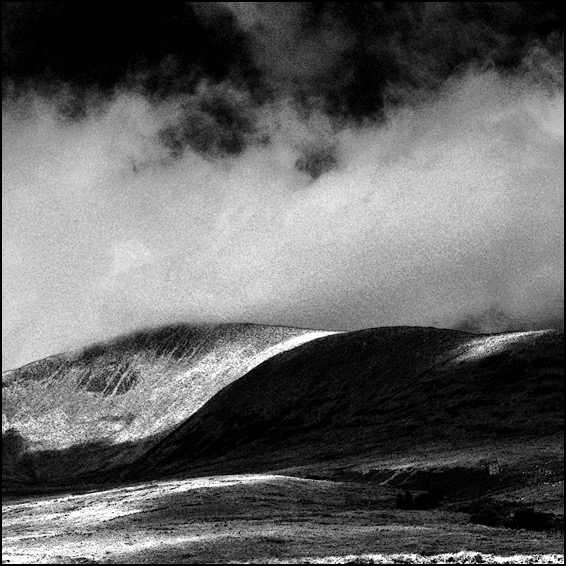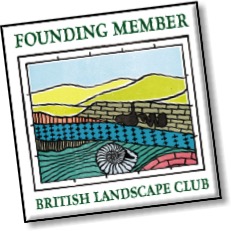Apr 2010
New Topographics and the lie of the land
Thursday, 29 April, 2010. Filed under: Photography
There’s an interesting article in today’s British Journal of Photography on how British landscape photography dropped its “chocolate-box pastoralism” in the 1970s in favour of a new radical vision exposed by the mores of contemporary American photographers like Robert Adams and others in the New Topographics movement - essentially a style of documentary landscape photography.
Eugenie Shinkle, the article’s writer, seems in favour of the New Topographics style and, indeed, the pictures are often powerful and interesting compositions, but his use of the rather judgmental term “chocolate-box pastoralism” is very telling. It seems we cannot properly appreciate a photograph of a striking landscape unless we place a caravan park or a shopping mall in front of it. Anything else runs the risk of being labelled “chocolate-box”. He also seems to regard it as something of a hallmark of the style that most of the photographs could be anywhere at all. The Robert Adams landscape, Mobile Homes, Jefferson County, Colorado, 1973, could be almost anywhere - I know of an almost identical view from a caravan park in Wales.
I like the edginess of these classic photographs, their documentary style and texture, but surely photographers haven’t given up finding ways of representing the power and sublime beauty of landscape without needing to crop their compositions to include a rusty tin roof or a multi-storey car park.
Eugenie Shinkle, the article’s writer, seems in favour of the New Topographics style and, indeed, the pictures are often powerful and interesting compositions, but his use of the rather judgmental term “chocolate-box pastoralism” is very telling. It seems we cannot properly appreciate a photograph of a striking landscape unless we place a caravan park or a shopping mall in front of it. Anything else runs the risk of being labelled “chocolate-box”. He also seems to regard it as something of a hallmark of the style that most of the photographs could be anywhere at all. The Robert Adams landscape, Mobile Homes, Jefferson County, Colorado, 1973, could be almost anywhere - I know of an almost identical view from a caravan park in Wales.
I like the edginess of these classic photographs, their documentary style and texture, but surely photographers haven’t given up finding ways of representing the power and sublime beauty of landscape without needing to crop their compositions to include a rusty tin roof or a multi-storey car park.
Comments
Win a hamper in our landscape photo competition.

To celebrate the launch of Lie of the Land, The British Landscape Club’s under-the-field-guide to the British landscape, we are running a photography competition to find Britain's best photographed landscape.
So get snapping those buxom hummocks, discordant coastlines and stone circles and submit them to the Lie of the Land Flickr photo pool at http://www.flickr.com/groups/lieoftheland/.
The winner - who will win a lovely picnic hamper - will be announced July 30 2010 Leading up to the announcement we will feature ten photos a week right here on the website. There will be also be runner-up prizes of signed copies of Lie of the Land.
For general competition terms and conditions go to:
http://www.panmacmillan.com/displayPage.asp?PageID=3823
Please be assured that your photos will only be used in connection with this competition and any publicity it generates - which may include the websites of national and local newspapers. The submitter retains all copyright to their photos and the right to a byline/credit where ever it is used.
A reminder for members & non-members
Tuesday, 20 April, 2010. Filed under: Members' News

Non-members: You have to be a member of the British Landscape Club to get a member’s badge, any other way - we think you’ll agree - is madness. Membership - like the badge - is completely free and only requires that you sign-up for our occasional newsletter re:view. All we ever do is send you a link to where you may find it and we never, ever give, sell or otherwise divulge your email address or any other personal details to anyone.
British Volcanoes: Ardnamurchan
If your holiday plans are threatened by geological violence this year, why not make the most of the disruption and stay in Britain instead? After all, there’s no need to be stranded on the other side of the world in pursuit of amazing landscapes when we have more than enough of our own - and that includes volcanoes.
At the risk of sounding like a Travelodge brochure, Britain’s volcanic heritage can be discovered in many locations across the UK from the wilds of Ardnamurchan to the slopes of Snowdonia - there are even city centre volcanoes for your convenience. We’ll be looking at all of these over the next few weeks, but we’re starting at mainland Britain’s most westerly point - not Land’s End as is popularly supposed, but the Point of Ardnamurchan in Scotland.
View Larger Map
The Ardnamurchan Peninsula, seen here courtesy of Google, was the site, around 65 million years ago, of intense volcanic activity. Over a period of approximately three million years, the Ardnamurchan volcano would have undergone a series of awe-inspiring eruptions culminating in the collapse of the cone and crater onto the chamber of molten rock beneath, forming the caldera - the remains of which we see today. The hotspot that created it may even be the same plume that now lies under Iceland obstructing your travel plans.
In the intervening period, wind, rain and, the most destructive of them all, glacial ice, have worn down the landscape. The following image is from the southern part of the crater itself, while the view north - like most of the journey along this road - is obstructed by the lie of the land.
View Larger Map
At the risk of sounding like a Travelodge brochure, Britain’s volcanic heritage can be discovered in many locations across the UK from the wilds of Ardnamurchan to the slopes of Snowdonia - there are even city centre volcanoes for your convenience. We’ll be looking at all of these over the next few weeks, but we’re starting at mainland Britain’s most westerly point - not Land’s End as is popularly supposed, but the Point of Ardnamurchan in Scotland.
View Larger Map
The Ardnamurchan Peninsula, seen here courtesy of Google, was the site, around 65 million years ago, of intense volcanic activity. Over a period of approximately three million years, the Ardnamurchan volcano would have undergone a series of awe-inspiring eruptions culminating in the collapse of the cone and crater onto the chamber of molten rock beneath, forming the caldera - the remains of which we see today. The hotspot that created it may even be the same plume that now lies under Iceland obstructing your travel plans.
In the intervening period, wind, rain and, the most destructive of them all, glacial ice, have worn down the landscape. The following image is from the southern part of the crater itself, while the view north - like most of the journey along this road - is obstructed by the lie of the land.
View Larger Map
Lay-by of the Week: Llyn Ogwyn
Friday, 16 April, 2010. Filed under: Landscapes | Lie of the Land
Back to Wales for this lay-by, sent in by BLC member SteveP
View Larger Map
Steve writes, “There are several lay-bys on this stretch of the A5 which are very popular with outdoorsy people. Looking west you can see Y Garn which has a nice cwm. and SSE you can see Tryfan, probably one of the best mountains in Wales. You can also see Llyn Ogwen, the lake alongside the road. You might prefer the lay-by closer to Ogwen Cottage as you can get a cup of tea there.”
Feel free to re-tweet the permalink and, as ever, if you have a favourite stopping-off point to view the scenery over a cup of warm thermos tea, drop us a line or leave a note in the forum.
View Larger Map
Steve writes, “There are several lay-bys on this stretch of the A5 which are very popular with outdoorsy people. Looking west you can see Y Garn which has a nice cwm. and SSE you can see Tryfan, probably one of the best mountains in Wales. You can also see Llyn Ogwen, the lake alongside the road. You might prefer the lay-by closer to Ogwen Cottage as you can get a cup of tea there.”
Feel free to re-tweet the permalink and, as ever, if you have a favourite stopping-off point to view the scenery over a cup of warm thermos tea, drop us a line or leave a note in the forum.
Lay-bys of the Week: Ravenscar and the Hole of Horcum
Monday, 12 April, 2010. Filed under: Landscapes | Views & Scenery
Two places to take in the sights in North Yorkshire this week - both in the North York Moors National Park. Ravenscar is a small village on the coast, between Whitby and Scarborough. Gorgeous views of Robin Hood's Bay can be enjoyed from this lay-by and we'd give this one a 4/5 Thermos rating.
View Larger Map
Further inland, on the A169 between Whitby and Pickering, lies the stunning vista of the Hole of Horcum - a spectacular, 400 feet deep natural amphitheatre, three-quarters of a mile across formed by glacial ice.
The Hole of Horcum is the first place in Lay-by of the Week to be close to one of those top-secret, hush-hush places perfectly visible to anyone with some petrol money and a valid tax disc, but shrouded in the strangely impenetrable Googlemist for virtual passers-by. It's incredibly foggy for about 50 yards outside the Yorkshire "RAF" base and none of the usual Street View navigation controls work. Presumably, if you stick around for too long, some men in balaclavas will crash through your ceiling and confiscate you. Stick to looking at the Hole of Horcum, if I were you. Lay-by rating 4/5.
View Larger Map
View Larger Map
Further inland, on the A169 between Whitby and Pickering, lies the stunning vista of the Hole of Horcum - a spectacular, 400 feet deep natural amphitheatre, three-quarters of a mile across formed by glacial ice.
The Hole of Horcum is the first place in Lay-by of the Week to be close to one of those top-secret, hush-hush places perfectly visible to anyone with some petrol money and a valid tax disc, but shrouded in the strangely impenetrable Googlemist for virtual passers-by. It's incredibly foggy for about 50 yards outside the Yorkshire "RAF" base and none of the usual Street View navigation controls work. Presumably, if you stick around for too long, some men in balaclavas will crash through your ceiling and confiscate you. Stick to looking at the Hole of Horcum, if I were you. Lay-by rating 4/5.
View Larger Map
